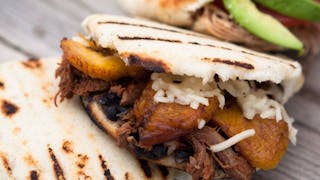

As the world becomes increasingly more globalized via the internet and social media, it can sometimes be hard to hold on to the parts of our own backgrounds and histories that remain special and unique to us and our families. But there is always a way. No matter how much of a melting pot our world becomes, there is no reason for time to erase culture or modernity to overcome tradition. The future presents opportunity and no one has embraced that more than Pica Pica owner and chef Adriana Lopez Vermut.

How It All Started
It all began in 2008 when Adriana gave birth to her first child. Her father asked her how she would make sure that her children would have a connection to their heritage as Latinos and specifically, as Venezuelans. Adriana and her father started Pica Pica together as a result and began their commitment to introducing Venezuelan cuisine to the Bay Area.
Originally, the plan was for a full-scale, fine dining concept to elevate their favorite flavors while making their presence known in the community. But with many diners less familiar with Venezuela than other Latin cuisines and the small size of their first location, a more streamlined approach was the best way to go. Their focus would become the arepa.
“We were the pioneers in bringing the concept of arepas around here. There were none,” said Adriana. “But it was a huge challenge, because people had no idea what they were.”
Adriana calls arepas the first cousins of pupusas and tacos and that’s a very apt description. Arepas have their origins in the cuisines of Colombia and Venezuela, where they are traditionally made with a thick corn flour pancake as the base. However, each country has put its own spin on the dish, resulting in a variety of different flavors and styles.
Colombian arepas are typically stuffed with cheese and/or eggs, while Venezuelan arepas can be filled with meats, cheeses, vegetables, or other ingredients. The cornflour shell of an arepa gives it a unique texture that is different from tacos or burritos, and it also helps to absorb the flavors of the other ingredients. As such, an arepa is more than just a vehicle for flavor like a traditional tortilla; it is a complex dish in its own right.
“They're all kind of in the same realm of food, but arepas are unique to just Venezuela and Colombia. It was a steep learning curve, but it was an opportunity to be the first ones at introducing that new flavor profile to the foodies in the Bay Area. And has been really fun,” said Adriana. “The Bay Area is really foodie-forward and adventurous, and people are always very intrigued to try new things. So that really helped us.”

Inclusivity Through Cooking
With a growing customer base, the Pica Pica team fielded a lot of questions about their product and one of the biggest questions they received was about whether or not their offerings were gluten-free. Traditionally, the arepa shells themselves are gluten-free because they used corn flour rather than wheat flour. But Adriana wanted to go deeper than that.
She wanted Pica Pica to be a safe space for customers with all types of dietary needs so she removed soy sauce from her recipes as well as honey to make sure that even her sauces were vegan and gluten-free. She wanted to adapt to the needs of the modern consumer while not losing the heart of the restaurant.
“I think that being welcoming to people's needs and bending over backwards to make sure people could still experience the arepa was an important driver for me from the beginning,” said Adriana. “And I have enjoyed that part of the process.”

Giving Back During COVID-19
Despite Pica Pica’s success, the COVID-19 pandemic hit everyone hard in March of 2020. The restaurant survived in part because of Adriana’s willingness to adapt.
By 2020, 50% of their sales were office catering orders so pivoting to a totally online ordering model was not an issue. But losing those sales and providing a safe avenue for her employees to continue working were struggles.
With the whole world turned upside down, Adriana knew she had to do something. She raised money from friends, family and several agencies across San Francisco and soon she and her team were providing hundreds of meals a day to homeless shelters and frontline workers.
From March 2020 to May of 2020, Adriana and her team provided over 21,000 meals to those in need which bridged the gap until they were able to get their PPP loan in June. As a result, she didn’t lose a single member of her team either.
“We made it work. It was not about making money, it was really just about helping people and keeping people employed,” she said.
What the Future Holds
Pica Pica’s sales have not completely returned to their pre-pandemic levels but they are on the rise. The restaurant remains a place that Adriana can connect to her family and her local community. She has four children now that will sometimes help out in the kitchen and she’s used Pica Pica as a place to teach them and their classmates about how to run a restaurant.
None of them have gotten the bug to take over and let Adriana retire but her daughter, Isadora, has already published a cookbook for kids called The Simple Art of Cooking. These days Isadora only cooks for personal fulfillment because she’s seen the headaches of running a business firsthand.
For now, Adriana remains committed to Pica Pica, the art of the arepa and continuing to listen to her customers.
“Sometimes people are like, ‘Oh, this [arepa] is not very big.’ But the ones that we make are anywhere from 12 to 15 ounces, so it's packed in there. And our combinations have sauces, Venezuelans don't do sauce, so I developed a sauce menu. It's hot, it's sweet, it has plantains, it has the beans, the tofu. That's a page from listening to the American customers,” said Adriana. “Arepas are a really versatile vessel to play around with. And that I think is what's so unique about it.”




